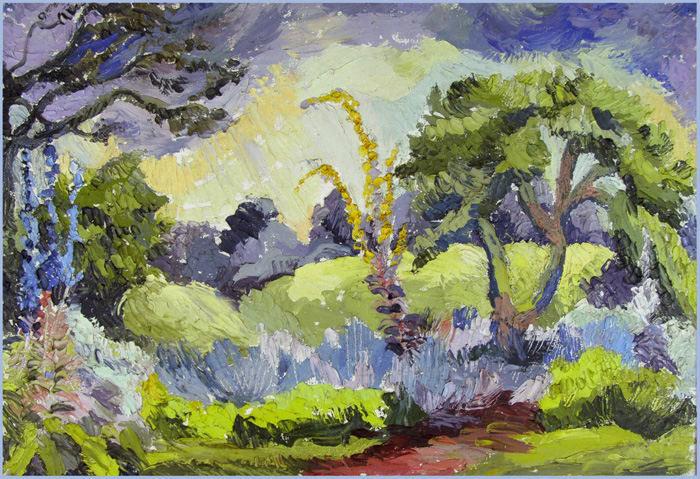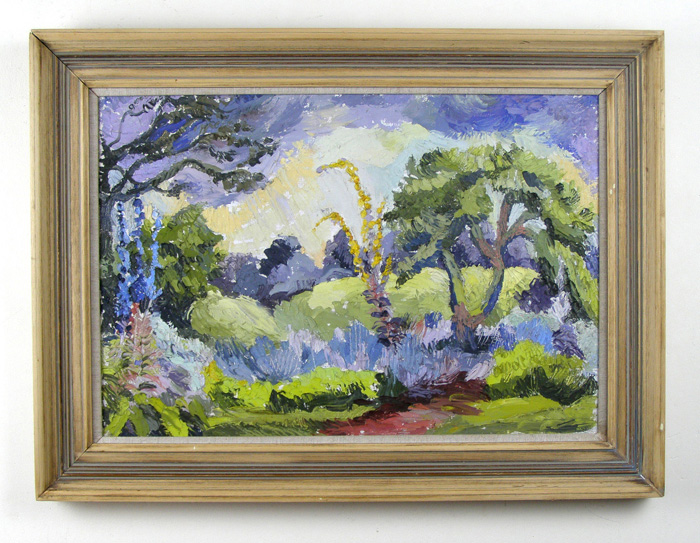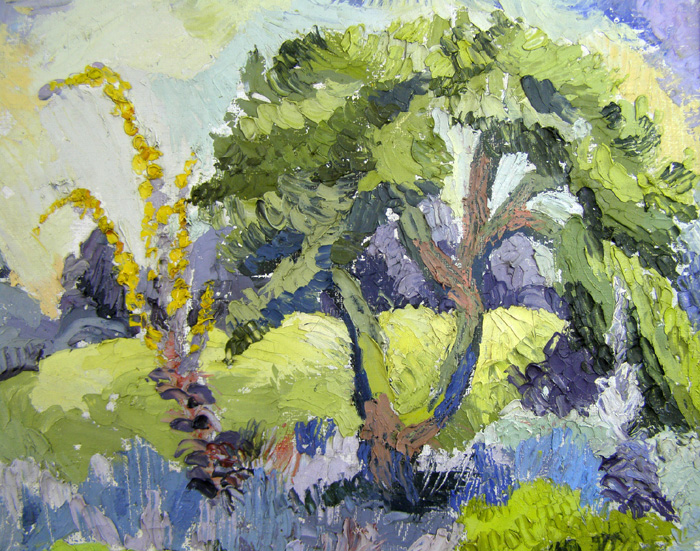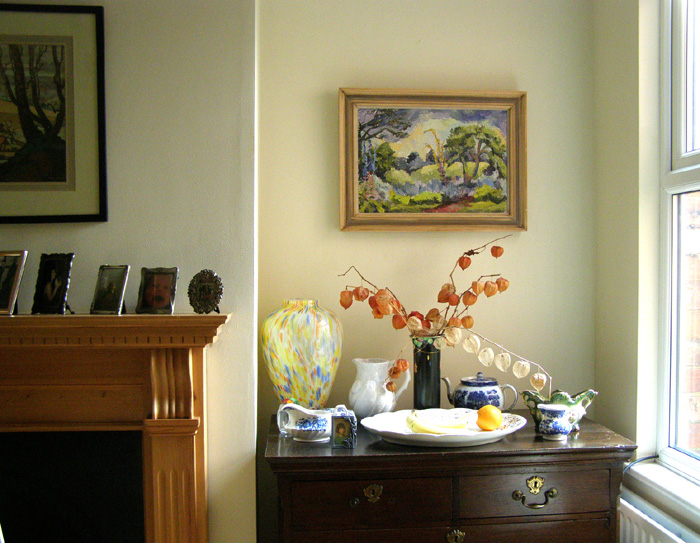
Sylvia Pollak (b.1912 - ?)
`Mullein in the Storm` 1946
A vibrant and colourful exciting post-impressionist landscape by post-war British Artist Sylvia Pollak, depicting plants in a windswept garden during a passing storm -the sun is just breaking through the clouds again. The painting is executed in an impasto style, with lots of interesting texture and brush strokes. In excellent condition, having been cleaned and revarnished. The actual location is noted on the stretcher, which is the artist Cedric Morris` Garden and dated 1946. We know a lot about Cedric Morris, and from 1940 until 1984 he lived at Benton End in Hadleigh, Suffolk -a rambling 16th century farmhouse, where he and his partner Lett Haines ran the legendary `East Anglian School of Painting and Drawing` and created a stunning garden for which it was famous. It seems reasonable to suppose that Pollak was either a visitor or a student here, it seems there were no formal lessons -artists would just turn up and paint in a free and easy bohemian atmosphere! Certainly the influence of Morris would appear to be evident, I`ve turned up a painting by him which seems related. There`s a potted history of the school below, and there are a number of books which make for interesting reading.
So what we have here is an interesting and important piece of postwar british art history from a creative and inspirational period, with connections to the British avant-garde of the 1940`s.
Painting is housed in a period oak distressed frame which suits it perfectly-ready to hang.
The painting bears labels indicating that it was exhibited at the Womens International Art Club probably in 1946 or 47. .
Founded in 1900 and originally called the Paris International Art Club. The Women's International Art Club as we know it today, afforded women the chance to show their art work to the general public. The inaugural exhibition under its new name was staged at the Grafton Galleries in London in 1900. The Club continued with annual exhibitions of paintings and sculptures until its demise in 1976. It also toured smaller shows around the UK and abroad. Exhibitors included Gwen Barnard, Eileen Agar, Orovida Pissarro, Ithell Colquhoun, Stanisława de Karłowska, Elisabeth Frink, Wilhelmina Barns-Graham and Gwen John.
****** NB. `Mullein` is the large yellow plant in the centre of the painting
Sylvia Pollak (1912-?) was a painter and designer, exhibition specialist and a writer on art. She studied at London University, the Bartlett School of Architecture, The Slade School of Art and in Paris and Vienna. Exhibited the AIA, WIAC, the Arts Council and in the provinces. A writer for `The Studio` and `Architectural Design`. Lived in London.
| Medium | oil on board | Condition | very good |
| Image size | 20 X 14 inches | Provenance | exhibition labels, tags, notes verso, dated |
| Overall size | 25 X 19 inches | ||
| Age | 1946 | Price | SOLD AUG 2017 |


Cedric Morris and the `East Anglian School of Painting and Drawing`
Sir Cedric Morris (1889-1982) was born in Swansea into a wealthy industrial family. In 1947 he succeeded his father as 9th baronet Morris. In 1914 he decided to study Art in Paris and for the next ten years or so studied at various Academies and travelled extensively in Europe and North Africa. During this period he met the artist Lett Haines in London in 1918 who became his lifelong partner. They moved to Newlyn, Cornwall, then to Paris. On returning to England, they established the East Anglian School of Painting and Drawing in 1937 at The Pound, near Higham, Suffolk, living and running the school in the farmhouse.
Following a fire at the School in 1940 they moved to Benton End, Hadleigh, Suffolk.
At its new location the School proceeded to attract a 'wide variety of odd and interesting people', and in its heyday had about 60 students. This was not surprising as it was run on uniquely individual, private terms; no formal classes at all. Many of the leading postwar figures in the art world visited. Barbara Hepworth and John Skeaping, Lucien Freud and Frances Hodgkins were friends, and at the age of fifteen, Hadleigh born Maggie Hambling attended the School. In the 1950`s Morris lectured at the Royal College of Art. As a painter Cedric Morris had a distinctive and often rather primitive post-Impressionist style, and painted portraits, landscapes and very decorative still lifes of flowers and birds.
Morris was equally well known as a plantsman and botanist, and created a fabulous garden at Benton End, which provided a great source of inspiration for students and visitors alike
`The heady garden of irises, the big lunches, the exotic visitors and the students were the School but over and above all, was the painting. .``.
After the 1960`s the school gradually wound down - Lett Haines died in 1978 and Cedric Morris in 1982.
Today he is commemorated in a number of plants, from a particularly brightly flowered lungwort, Pulmonaria longifolia 'Cedric Morris’, to an early-flowering daffodil discovered on a rocky ledge in northern Spain, Narcissus minor 'Cedric Morris’. .
Most of all, Morris is associated with irises. Time and again, in yellow and white and blue, he painted their bold geometry, their elegant fall of petals.
In his Suffolk garden he grew around 1,000 new iris seedlings a year. His introductions include the first pink iris bred in Britain. He named it, possibly mischievously, 'Edward Windsor’, after King Edward VIII, who abdicated in 1936, and registered it with the British Iris Society in 1945. Seven years later, he achieved another hit with the milky-mauve-flowered iris 'Benton Cordelia’. In his gardening, as in his painting, Morris’s preoccupation was with colour.